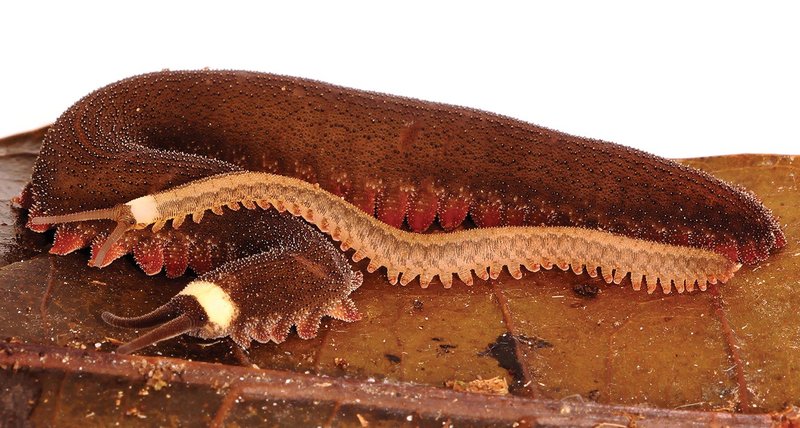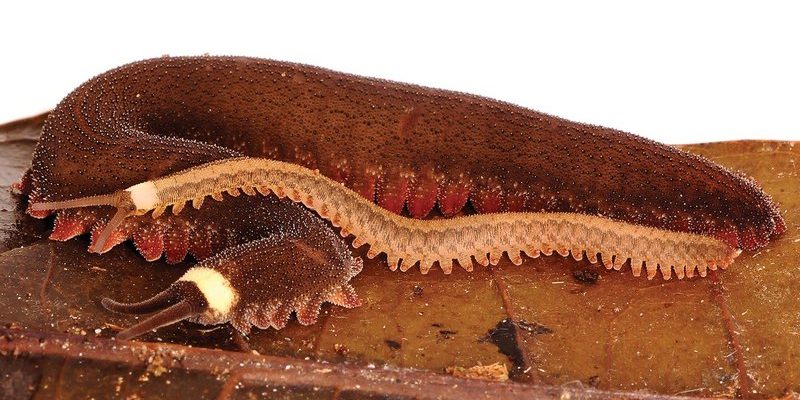
Now, let me tell you, the fossil records of velvet worms are like a time capsule, revealing just how these creatures have adapted and thrived through the ages. They allow us to peek into a world that was, in many ways, vastly different from our own. So, grab your favorite drink, and let’s dive into the remarkable journey of velvet worms through the fossil record!
What Are Velvet Worms?
Velvet worms, or *Onychophora*, are soft-bodied invertebrates that mostly inhabit humid, tropical environments. Picture a tiny, squishy creature with a velvety appearance and multiple pairs of legs. These little guys are like nature’s very own living fossils, connecting modern ecosystems to ancient ones. Honestly, they’re a bit of a rare breed in today’s animal kingdom!
You might be wondering what makes them so unique. Well, velvet worms have some cool features that set them apart. For one, they possess a unique method of hunting. They use slime to catch prey, which is surprisingly effective in their moist environments. Imagine lobbing a sticky web to ensnare unsuspecting insects—that’s basically how they roll!
Another fascinating aspect is their evolutionary history. Scientists believe that velvet worms share a common ancestor with both arthropods (think insects and spiders) and annelids (like earthworms). This connection is super interesting because it offers a glimpse into how life has evolved on Earth.
A Brief History of Velvet Worm Fossils
The fossil record for velvet worms is quite limited, primarily because their soft bodies don’t fossilize well. However, there are significant finds that help map out their ancient lineage. The oldest known velvet worm fossils date back over 500 million years, nestled in Cambrian deposits. It’s astonishing, really, when you think about how long these creatures have been around!
When paleontologists discovered these fossils, they found striking similarities between ancient and modern velvet worms. For instance, some fossils had well-preserved features like legs and the slime-producing glands. This indicates that they have retained many of their traits for millions of years. It’s as if they’ve found a winning formula and stuck with it!
Furthermore, the rarity of these fossils adds to their significance. Each discovery helps fill in the gaps of our understanding of early life on Earth. It’s kind of like piecing together a jigsaw puzzle where half the pieces are missing!
The Evolutionary Journey
As velvet worms evolved, they adapted to their environments in remarkable ways. Their soft bodies allowed them to thrive in moist, sheltered habitats, making them agile and effective hunters. You could compare their survival strategies to a savvy survivor in a game—always adjusting to the challenges of their environment.
The evolutionary path of velvet worms diverged significantly around 500 million years ago. Their ancestors adapted to life on land, which led to the development of key features like specialized legs and slime glands. This adaptation was crucial for their hunting strategy, making them efficient predators in the lush, prehistoric forests that once blanketed the Earth.
Interestingly, this evolutionary journey gives us clues about how other life forms have adapted over time. Velvet worms are living proof that sometimes, sticking to the basics and honing your skills is the key to survival. By maintaining their ancient traits, they show us that evolution doesn’t always mean becoming something entirely new.
Significant Fossil Discoveries
Several key fossil discoveries have shed light on the world of velvet worms. One of the most exciting finds came from the famous Burgess Shale formation in Canada. Dating back to around 505 million years ago, fossils from this site revealed details about velvet worms that had not been seen before, including their leg structures and overall body plan.
Another noteworthy discovery was made in the Solnhofen limestone in Germany, known for preserving extraordinary fossils. Here, researchers unearthed velvet worm fossils that provided insights into their morphology and behavioral adaptations. This fossil evidence highlighted the diversity of velvet worms during the Paleozoic era, showcasing how they were once more varied than we see today.
These significant finds aren’t just academic; they help us understand the ecological roles velvet worms played in their environments. By studying these fossils, scientists can gather clues about the ecosystems of the past and how different species interacted.
Why Velvet Worms Matter Today
You might be asking yourself, “What’s the big deal about velvet worms?” Well, they hold crucial information about our planet’s evolutionary history. Their ability to survive and adapt through massive geological changes provides a window into climate resilience. In a world facing rapid environmental change, understanding these ancient survivors may offer insights into how modern species could cope.
Additionally, by studying velvet worms, scientists can learn more about the evolution of terrestrial life. They bridge gaps in our knowledge of how multi-legged animals transitioned from aquatic to terrestrial environments. It’s like having a living laboratory that demonstrates the principles of evolution in real time.
Furthermore, these creatures can also inspire biomimicry—innovation inspired by nature. Their unique slime secretion could lead to advancements in materials science or medicine. Who knows? The next breakthrough in tech or healthcare might come from studying these prehistoric survivors!
Conservation and Future Research
While velvet worms are extraordinary, they are also vulnerable to habitat loss and climate change. As their moist, forested habitats are threatened, the survival of these creatures hangs in the balance. Conservation efforts are essential to preserving not only velvet worms but the ecosystems they belong to.
Researchers are working to understand the impacts of environmental changes on velvet worm populations. Future studies may focus on their genetic diversity, behavior, and ecological roles. This knowledge is vital for developing conservation strategies aimed at protecting these fascinating creatures.
If you’re ever out in a humid forest, keep an eye out for these little guys! Understanding their lives can help foster a love for biodiversity and the importance of conserving our planet’s unique ecosystems.
Velvet worms are truly remarkable creatures with a rich prehistoric legacy. Their fossils tell stories of survival and adaptation that stretch back hundreds of millions of years. By studying these ancient beings, we gain insights into evolution, ecology, and the resilience of life on Earth.
So, the next time you think about prehistoric life, remember the velvet worm. It may not be a dinosaur, but it’s a survivor in its own right, demonstrating that sometimes, the simplest designs are the most effective. As we continue to explore and protect our natural world, let’s not forget the incredible journey of these soft-bodied marvels.

